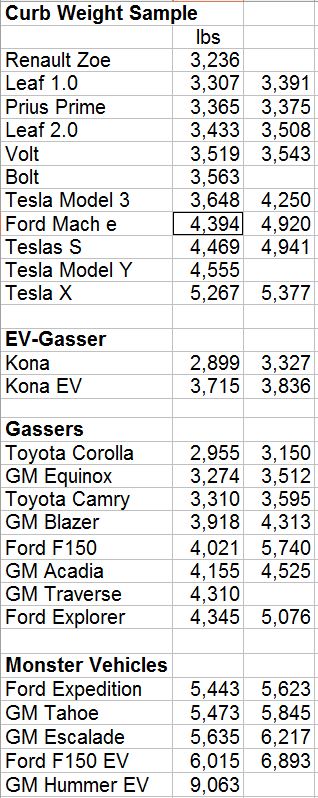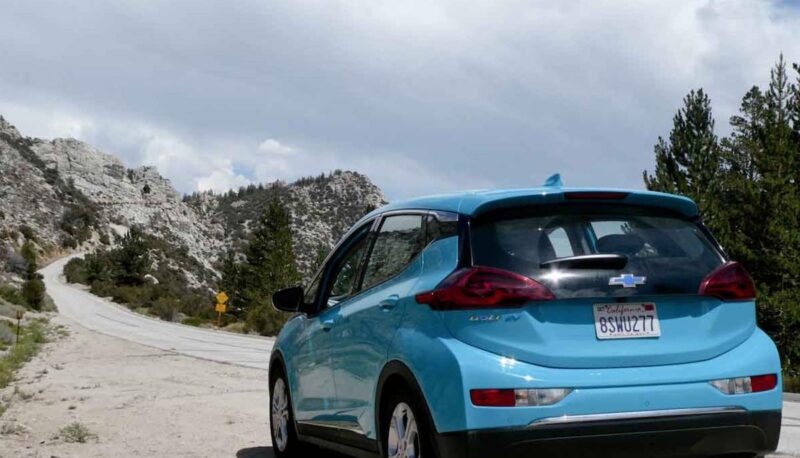The latest in a long line of anti-EV propaganda is that the weight of Electric Vehicles will crush the world—or at least parking structures and bridges. You can relax. No, they won’t.
Monster SUVs maybe, but EVs as EVs, no, not likely.
Normally, I try to keep my head down and get my work done. I try not to pay attention to the latest “this new wind turbine will save the world” scam, or the latest flimflammery from nuclear and fossil-fuel lobbyists.
(Hey, I live in Bakersfield, California. I get oil industry flyers in the mail. Yes, the mail, physical full color brochures. They spare no expense to keep me informed.)
Then on occasion there’s something so over the top I have to step in. Or, more likely, a friend contacts me and says, “What do you think of this?”
And that’s what happened here. A friend, who drives a compact EV, said a friend of hers was worried about the weight of EVs bringing down parking garages. A “friend of a friend” is exactly how this chain-mail stuff works. Nobody bothers to check the source and they keep circulating the stuff.
Argh!
My knee-jerk reaction was: “Oh, come on. Parking garages are massive structures of concrete and steel. They have to be strong to just hold themselves up. The cars are an item in the calculation, but unlikely a determining factor and the differences between vehicles will not make an order of magnitude difference. This smells of FUD (Fear, Uncertainty, and Doubt).”
So I did a quick search of vehicle curb weights of EVs and gassers. Yes, there are differences. For a comparable size vehicle, EVs are heavier, but not an order of magnitude heavier by any means.
My friend drives a Kona EV. Hyundai also builds a Kona fuelled by gasoline. The Kona EV weighs from 15% to 28% more than the gasser depending upon trim level.

This confirmed my suspicion of FUD. Something was fishy about this new found “concern.”
The next question that came to mind was which rightwing outfit started this?
I still don’t know which one of the many Koch-funded think tanks did the research behind it—if any–but in a 10 April article by Steve Hanley (FUD Alert: Weight Of Electric Cars Will Cause Parking Garages To Fall Down) he identified the Daily Mail. And Hanley—who I follow for his insightful and no-holds barred style—lets the Daily Mail have it.
For those who don’t know, Britain’s Daily Mail is not an authoritative source—for anything. I’ve dealt with the Daily Mail. See Paul Gipe Response to Daily Mail Claim of 14,000 Abandoned Wind Turbines, and Debunking Anti-Wind Myth of 14000 Abandoned Wind Turbines in California. The Daily Mail has an agenda and its content reflects that.
Then, Hanley found, the Telegraph picked it up and from there it went to Australia and from there it landed in North America where a series of unthinking accounts appeared in digital news feeds. Each new story relying on the authority of the last source.
The process reminded me of how the old canard of the “14,000 abandoned wind turbines” kept going around the globe for years. The Daily Mail’s fingerprints were on that one too.
Then on 18 April a poorly-maintained parking garage in New York City collapsed and that gave the issue “legs” as we say in the media.
I suggest reading Hanley’s piece at CleanTechnica. He reached the same conclusion I did from a slightly different direction. He noted the problem—if in fact there is a problem–is not that EVs are heavier; it’s that all vehicles have become much more massive than those built fifty years ago—or even a few decades ago.
This is what jumped out at me when I sampled the curb weight of some current vehicles, EVs and otherwise. Some hulking SUVs are monsters whether EVs or gas-powered. The Ford Expedition, GM’s Tahoe, and GM’s Escalade all weigh more than Tesla’s Model X, the biggest in its line.
So if parking garage owners or those responsible for ageing bridges are concerned about weight, they need to screen out monster SUVs, not EVs. Of course this is not noted in the articles “concerned” about the weight of EVs.
Nor do these articles mention the volume of each type of vehicle sold. It’s not any one vehicle’s weight that will make a bridge fall down, but the mass of all of them together.
Tesla’s Mode X weighs 1,600 pounds more than the Model 3, but very few of the Model X are sold compared to the other models. In 2022 Tesla delivered nearly 600,000 Model 3s—twenty times more than the massive Model X.
Let’s take GM as another example. In 2022 GM sold 1,000 of its monster SUV, the Hummer EV. You could build almost three Chevy Bolts for every Hummer. Yet, there were 40 times more Bolts sold in 2022 than Hummers. Should anyone worry about the few Hummers out there? Doubtful.
Ford’s F150 Lightning is nearly twice the mass of a Chevy Bolt. But how many were sold last year? Less than 16,000 versus the 800,000 of the F150 gasser.
GM’s Escalade, one of the biggest and heaviest gassers built, tips the scales almost as much as the F150 Lightning. GM sold 24,000 of the behemoths last year. If someone was really concerned about weight, they’d be looking at GM and Ford’s big SUVs, not EVs in general.
Big vehicles are a problem—for many reasons—not EVs
Big EVs are still just a blip on the scale of big vehicles being manufactured today that bridges and parking garages must accommodate.
So, if you think about it for more than a second, poke around a little, tally up some numbers, the issue of EV weight is a nothing sandwich that doesn’t stand up to scrutiny.
FUD, as I said.
Paul Gipe writes about renewable energy and electric vehicles. This article was first published at Wind-works.org. Reproduced with permission of the author.


